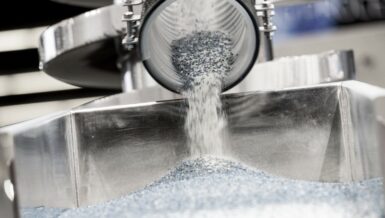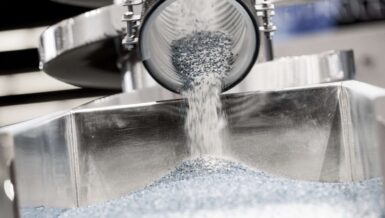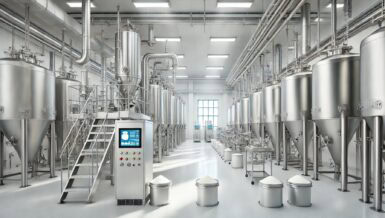Powder processing is a specialized field. With more than 10 thousand powders available in the marketplace, each with distinctive characteristics and behaviors, coupled with discrete needs of each production line, expertise in vacuum technology, knowledge of production equipment and processes, and a full understanding of material characteristics, is essential to designing powder transfer systems that truly contribute to the bottom line.
Automating manual transfer of powders via pneumatic, aero mechanical and flexible screw technology, is one of the most common capital investments in industry today due to its high ROI from increased efficiency, reduced labor, eliminating respiratory and ergonomic liabilities, ingredient preservation, bolstering product quality, and overall plant safety and cleanliness.
Vacuum conveyors are the most hygienic method for transfer of powders and bulk solids. These conveying systems are fully enclosed, protecting materials from air, dirt and waste. Because product does not escape from a vacuum conveying system, particulates that can endanger worker health, jam expensive equipment or result in cross contamination do not escape into the environment.
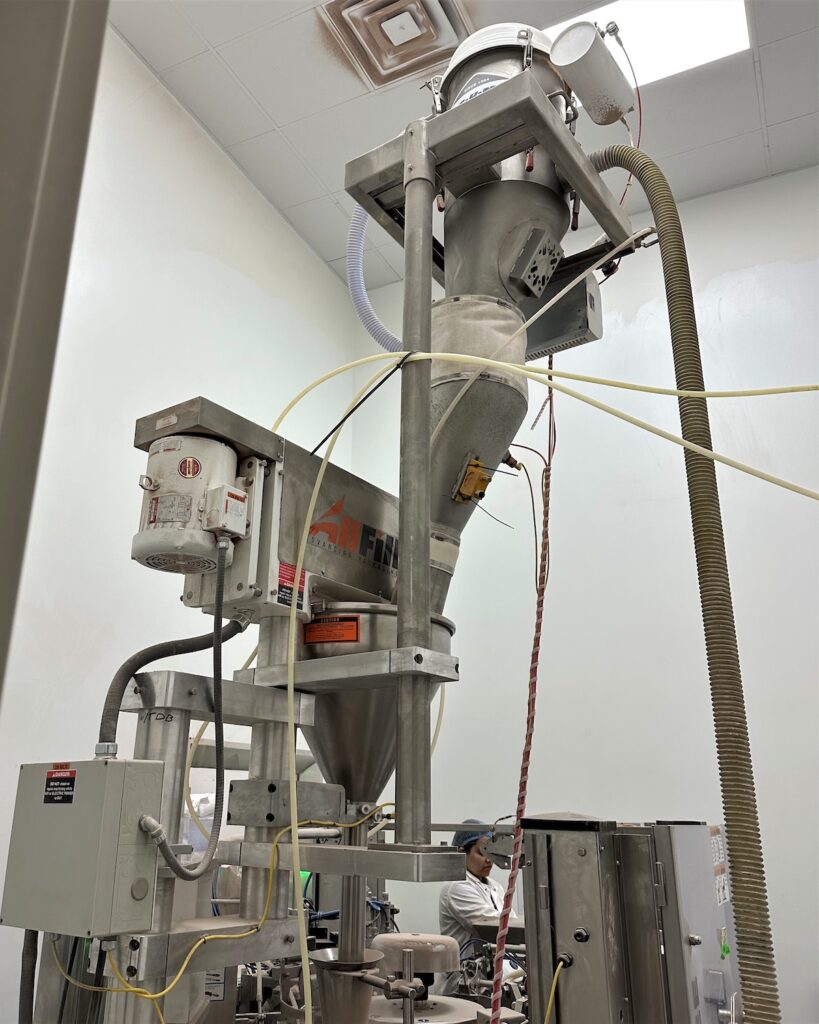
The simplicity of vacuum conveying systems, consisting of only four components, sometimes lends to the misconception that vacuum conveying systems are just fancy heavy duty vacuum cleaners. While they may be born from the same vacuum technology, transferring powders and bulk solids, as opposed to sucking up waste and debris, is challenging.
Vacuum conveyor design is determined by several factors such as material size, material bulk density, material characteristics, conveying distance, upstream and downstream equipment, plant layout, overhead clearances and even environmental factors.
Automation looks different for each organization and/or processing line. Sometimes, automating powder transfer is simply a matter of growth where manual transfer is no longer an option to keep up with demand. Often it is a solution to a safety hazard that costs the organization money in terms of disability claims (commonly musculoskeletal) or reduces the number of workers needed to load equipment manually.
Whether it is a complex PLC-controlled, computer-compatible, multi-ingredient storage batching and processing system, or a simple “up and in” material transfer system, powder transfer with vacuum conveyors often need some level of customization to avert potential issues that can interrupt operations.
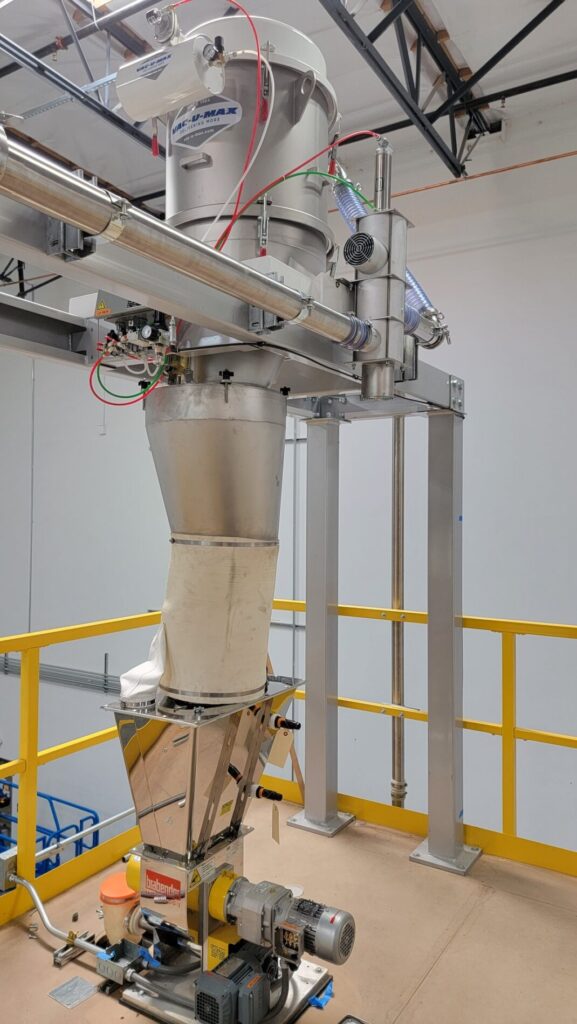
While there may be many vacuum conveyors on the market, only a handful of vacuum conveyor manufacturers have the ability to adapt equipment, supply ancillary equipment or offer alternative technologies such as aero mechanical conveyors or flexible screw conveyors to deliver fully integrated powder processing lines with factory acceptance testing (FAT) that guarantees equipment performance.
Even with seemingly simple applications, like a pre-engineered “up and in” conveying system for relatively easy materials to convey, like wax chips, the first step in conveyor system design is a detailed inquiry with the customer that delves beyond basic material considerations, conveying speed and conveying distance. These inquiries inform the conveyor manufacturer of potential issues that will need ancillary equipment or a custom solution to guarantee fully integrated, flawless systems.
With some systems, conveyor design may be uncomplicated, and the control system is what sets the system apart. Conveyor manufactures that are also U.L. listed builders and suppliers of electrical control panels and PLCs are able to meet process requirements.
When an organization that employs blind and visually impaired individuals needed a conveyor system to deliver detergent from 2000-pound supersacs to an auger filler, the customer wanted to be sure that the control systems from the two systems fully integrated with one another. To confirm this, FAT of the vacuum conveyor was performed at the auger filler manufacturer’s facility demonstrating that the two systems were fully integrated and operational.

The filling system was designed so that individuals who are blind or visually impaired can operate the line. For this system, an operator uses a wand, inserted into a supersac, to pull material into the conveying line to the filling machine. Audible alarms on the auger filler alert operators that they need to move the wand to a different location within the bag if the conveying system is not sucking detergent into the hopper.
When the boxes are full, an audible signal lets operators know they can move it away from the filling station to another location to seal the box. The system also utilizes a touch screen for further assistance that provides audible explanations of whether the process is working properly or not.
Using a wand to feed conveying systems is a common low-cost option for lower volume applications to automate powder processing systems while still reducing manpower needs and ergonomic hazards. Other options are fully automated super sack unloading equipment or bag dump stations with integral dust collection that eliminates dust from entering the environment during dumping.
In difficult situations seasoned manufacturers with tribal knowledge of applications and experience with 10s of thousands of materials often select standard equipment that is an 80 percent fit and then engineer and fabricate the other 20 percent to fit the application.

What seems like a complicated procedure to the layman can be rather simple to an expert pneumatic conveying manufacturer as was the case when super absorbent polymer was escaping into the environment during processing at a cable producing facility. The goal was to eliminate the SAP dust from entering the air around the operator’s environment during cable manufacturing, reclaim excess material from the coating chamber and eliminate clogging occurring in the old bag dump station.
The solution was a dual conveyor system, with automatic changeover, programmed to work essentially like that of a pumping heart. First, cable enters into a chamber at about 400-600 feet per minute while an atomizer simultaneously injects positive air and SAP into the chamber wherein it coats the cable fibers. At that same time, the dual conveyor system sucks air out of the chamber at a faster rate than it enters the coating chamber, creating the negative pressure system wherein SAP cannot escape into the air external to the coating chamber.
After material enters the first of two valved chambers for a particular number of seconds, the first valve closes while opening the second valve and chamber. When the first valve closes, air is blasted into the filter to release any particulates to the bottom of the system where another routing system returns the SAP back into the hopper for reuse. This filtration cleaning process is repeated for a few seconds until the first filter is entirely clean, and then the second valve closes to clean the filter on the second conveyor.
Now, instead of losing 7 percent of their material per shift, the new system integrates with a reuse system bringing material loss to nearly zero. Workers exposed to fugitive SAP experienced sensitivity in their eyes and nasal passages and led to high turnover in the department. The new vacuum conveying system eliminated the hazard.
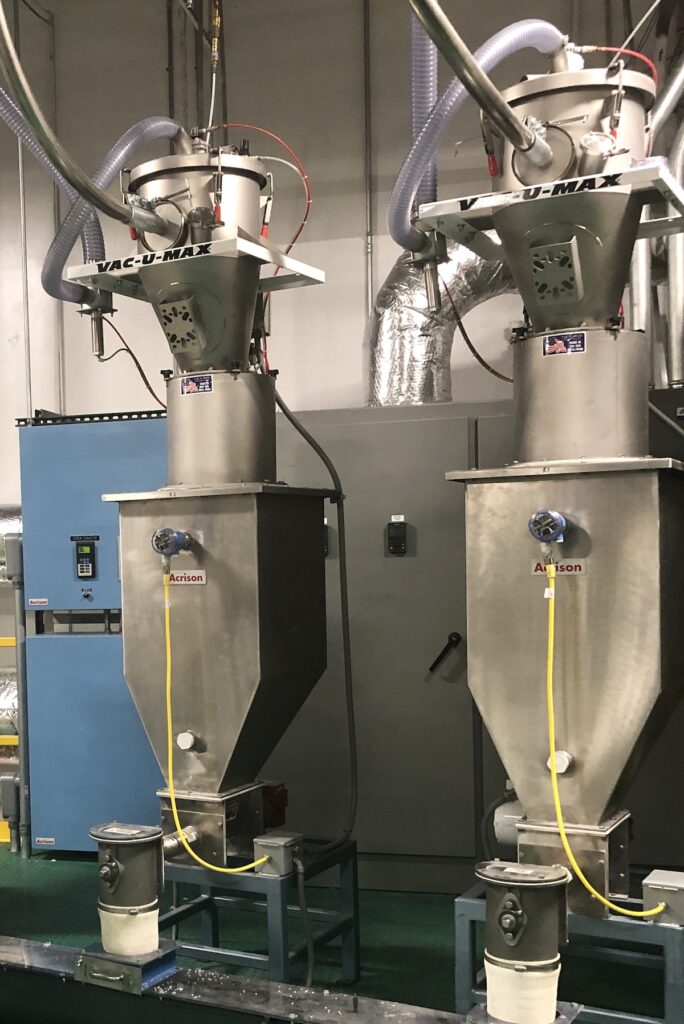
As difficult as SAP is to transfer, sometimes new compounds of powders seem impossible to convey with vacuum conveyors. Most of the time getting material to convey in the conveying tube is not a problem but getting it to automatically feed into the conveying tube is.
Such was the case when designing two custom vacuum conveying system from the ground up for a new compounding facility for a global leader in optimized heat management system. Due to the very dense, sticky characteristics of the exotic powders, the seemingly simple process of transferring materials into the compounding extruder, presented its own set of challenges— conventional equipment did not work with the materials that clumped together and would not convey.
Part of the solution to get the material to automatically feed into the conveying line was born from a previous application from a very different industry. Although the makeup of the materials is completely different, the characteristics were similar, and that knowledge led to a resolution for the exotic powders.
The solution was a customed designed bag dump station that incorporated the design of a bulk bag unloader fabricated specifically for the dense sticky powder that could either unload a supersac or 50-pound bags.
Integrating powder processing systems with automated powder transfer requires a deep understanding of how powders behave and interact with upstream and downstream equipment. This tribal knowledge allows precision engineering of vacuum conveying systems that eliminate safety hazards associated with manual handling, prevents dusts from entering the environment, reduces labor costs; and when designed properly, becomes a set it and forget it system that streamlines production.








